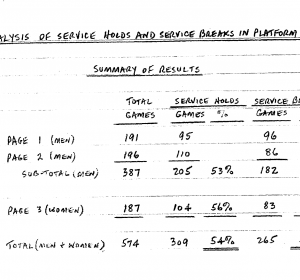Is there an advantage to service?
During his tenure as the chair of the APTA Rules and Equipment Committee Robert A Brown had conducted a number of surveys of service holds and breaks, in part because of the no-let decision in the late 1990s. In 2003 he updated his earlier work with and analysis on the 20003 Senior Men’s 50+, 60+ and 70+ championships and filed the following report with PTM.
In discussions with players about the “pros” and “cons” of the no-Jet on net cord serve rule, the conversation usually progresses to a question as to whether the server In platform tennis has an advantage in serving. The “con” proponent will generally comment that this is the case and that the no-let rule further favors the server. While there Is a modicum of truth to the latter comment, It is not a significant factor, since most of the net-cord serves are returnable and the Incidence of the “dribbler” occurs on less than one-half of one percent of the serves delivered.
Regarding the question as to whether the no-let rule does, or should, help the server, maybe a case can be made that such help Is needed. Research has shown that service holds and service breaks In platform tennis are roughly 50/50, with some variation for men and women. The usual reaction to this fact: “That’s hard to believe!” That is a natural reaction from players· whose exposure to tennis over the years reflects the known dominance of the server In tennis – the result of having two serves, improved equipment and no wires. In platform tennis, with one serve and friendly wires, it’s a different story.
In a (limited) update of prior research, the chair umpire’s score cards for the championship matches in the 2003 Senior Men’s 50+; 60+ and 70+ tournaments were analyzed and yielded the following results:
In the 50+ final, Jean Kempner / Jim McNitt vs Steve Nycum / John Stefanik, a total of 30 games were played In three sets. There were 13 service holds and 17 service breaks.
In the 60+ final, Alan Graham / Stu Opdycke vs. Roy Anderson / Joe Holmes,a total of 17 games were played in two sets. There were 8 service holds and 9 service breaks.
In the 70+ final, Bob Brown / Dave Childs vs. Herb Bascome / Blair LeRoy, a total of 34 games were played in three sets. There were 17 holds and 17 breaks of service.
Grand total for the three matches: 81 total games (a pretty good sample), 38 service holds, 43 service breaks. (47% holds, 53% breaks)
These results seem to be typical of results in prior research for the men. Prior studies on the women indicated a higher percentage of service holds (56%) and a lower percentage of breaks (44%) which may be a reflection of a generally less offensive serve returns (?).
What about the average players, or players of lesser ability? While their performance has not been studied, It Is likely that we would find similar results or possibly an even lower percentage of service holds, since serves are weaker, providing as added advantage to the returner, and faults are more frequent.
So, aside from the matter of consistency between the net-cord on service and the net-cord during a rally, considering the generally poor service-hold performance, what’s wrong with giving the server a little help?




